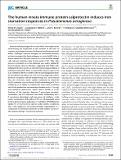The human innate immune protein calprotectin induces iron starvation responses in Pseudomonas aeruginosa
Author(s)
Zygiel, Emily M; Nelson, Cassandra E; Brewer, Luke K; Oglesby-Sherrouse, Amanda G; Nolan, Elizabeth M
DownloadPublished version (1.678Mb)
Publisher with Creative Commons License
Publisher with Creative Commons License
Creative Commons Attribution
Terms of use
Metadata
Show full item recordAbstract
© 2019 Zygiel et al. Published under exclusive license by The American Society for Biochemistry and Molecular Biology, Inc. Most microbial pathogens have a metabolic iron requirement, necessitating the acquisition of this nutrient in the host. In response to pathogen invasion, the human host limits iron availability. Although canonical examples of nutritional immunity are host strategies that limit pathogen access to Fe(III), little is known about how the host restricts access to another biologically relevant oxidation state of this metal, Fe(II). This redox species is prevalent at certain infection sites and is utilized by bacteria during chronic infection, suggesting that Fe(II) withholding by the host may be an effective but unrecognized form of nutritional immunity. Here, we report that human calprotectin (CP; S100A8/S100A9 or MRP8/MRP14 heterooligomer) inhibits iron uptake and induces an iron starvation response in Pseudomonas aeruginosa cells by sequestering Fe(II) at its unusual His6 site. Moreover, under aerobic conditions in which the Fe(III) oxidation state is favored, Fe(II) withholding by CP was enabled by (i) its ability to stabilize this redox state in solution and (ii) the production and secretion of redox-active, P. aeruginosa–produced phenazines, which reduce Fe(III) to Fe(II). Analyses of the interplay between P. aeruginosa secondary metabolites and CP indicated that Fe(II) withholding alters P. aeruginosa physiology and expression of virulence traits. Lastly, examination of the effect of CP on cell-associated metal levels in diverse human pathogens revealed that CP inhibits iron uptake by several bacterial species under aerobic conditions. This work implicates CP-mediated Fe(II) sequestration as a component of nutritional immunity in both aerobic and anaerobic milieus during P. aeruginosa infection.
Date issued
2019Department
Massachusetts Institute of Technology. Department of ChemistryJournal
Journal of Biological Chemistry
Publisher
Elsevier BV
Citation
Zygiel, Emily M, Nelson, Cassandra E, Brewer, Luke K, Oglesby-Sherrouse, Amanda G and Nolan, Elizabeth M. 2019. "The human innate immune protein calprotectin induces iron starvation responses in Pseudomonas aeruginosa." Journal of Biological Chemistry, 294 (10).
Version: Final published version